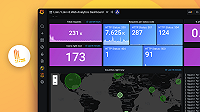Important: This documentation is about an older version. It's relevant only to the release noted, many of the features and functions have been updated or replaced. Please view the current version.
Using k6 for load testing
Grafana k6 is a modern load-testing tool. Its clean and approachable scripting API works locally or in the cloud. Its configuration makes it flexible.
The xk6-loki extension permits pushing logs to and querying logs from a Loki instance. It acts as a Loki client, simulating real-world load to test the scalability, reliability, and performance of your Loki installation.
Before you begin
k6 is written in Golang. Download and install a Go environment.
Installation
xk6-loki is an extension to the k6 binary.
Build a custom k6 binary that includes the xk6-loki extension.
Install the
xk6extension bundler:go install go.k6.io/xk6/cmd/xk6@latestCheck out the
grafana/xk6-lokirepository:git clone https://github.com/grafana/xk6-loki cd xk6-lokiBuild k6 with the extension:
make k6
Usage
Use the custom-built k6 binary in the same way as a non-custom k6 binary:
./k6 run test.jstest.js is a Javascript load test.
Refer to the k6 documentation to get started.
Scripting API
The custom-built k6 binary provides a Javascript loki module.
Your Javascript load test imports the module:
import loki from 'k6/x/loki';Classes of this module are:
Config and Client must be called on the k6 init context (see
Test life cycle) outside of the
default function so the client is only configured once and shared between all
VU iterations.
The Client class exposes the following instance methods:
Javascript load test example:
import loki from 'k6/x/loki';
const timeout = 5000; // ms
const conf = loki.Config("http://localhost:3100", timeout);
const client = loki.Client(conf);
export default () => {
client.pushParameterized(2, 512*1024, 1024*1024);
};Refer to
grafana/xk6-loki
for the complete k6/x/loki module API reference.



